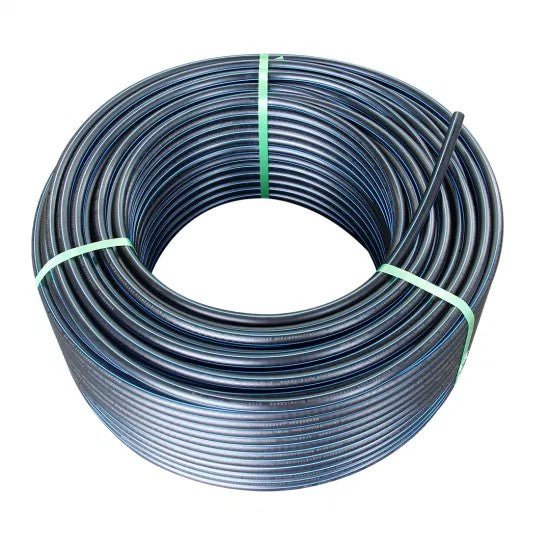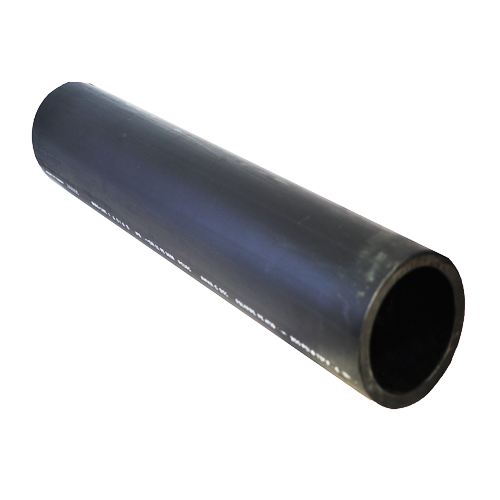Exploring American Plastics HDPE Pipe Manufacturing and Its Impact in Modern Infrastructure
Wiki Article
Discover the Manufacturing Process Behind High-Quality HDPE Pipeline and Its Applications
The production process of high-grade HDPE pipes is detailed and methodical. It begins with the choice of raw products that boost efficiency. Following this, ethylene undergoes polymerization to develop resin, which is after that formed via extrusion. Quality control is extremely important, making sure that the end product fulfills stringent criteria. Nonetheless, the journey of HDPE pipes doesn't end with manufacturing. Their applications throughout different industries reveal a wider value worth checking out.Comprehending HDPE: Properties and Advantages

High-density polyethylene (HDPE) is a versatile polycarbonate understood for its longevity and resistance to various ecological aspects. This material shows excellent tensile strength, making it suitable for requiring applications. Its low-density framework contributes to a lightweight product, helping with ease of handling and setup. HDPE likewise showcases exceptional resistance to chemicals, which lessens degradation when exposed to extreme compounds.
The product's reduced moisture absorption even more improves its longevity, making it excellent for usage in pipes and tank. In addition, HDPE is resistant to ultraviolet (UV) radiation, making certain that items keep their integrity even when subjected to sunlight. Its adaptability allows for the production of detailed shapes without endangering strength. The environment-friendly nature of HDPE, usually stemmed from recycled materials, includes in its appeal, advertising sustainable practices in manufacturing. Generally, these properties and benefits make HDPE a favored choice for various commercial and consumer applications.
Resources Choice for HDPE Manufacturing
The selection of raw materials for HDPE manufacturing is important to confirm the last product fulfills the wanted specs and high quality standards. High-density polyethylene (HDPE) is mostly generated from polymerized ethylene, derived from nonrenewable fuel sources such as all-natural gas or petroleum. The quality of these feedstocks greatly affects the mechanical and thermal homes of the last HDPE.Ingredients likewise play a significant role in boosting HDPE's performance, including antioxidants, UV stabilizers, and colorants, which boost toughness and resistance to environmental elements. The option procedure must consider not only the chemical composition of the raw products but also their processing qualities to guarantee effective production.
The sourcing of raw materials must focus on sustainability and compliance with environmental guidelines, as responsible methods are necessary in today's market. Eventually, mindful basic material option lays the structure for producing premium HDPE pipelines appropriate for varied applications.
The Extrusion Process: Shaping HDPE Pipeline
The extrusion process plays a vital duty in shaping HDPE pipelines, starting with thorough product prep work techniques that ensure suitable circulation and consistency. Equally essential is the design of the die, which directly influences the last measurements and surface area high quality of the pipe. With each other, these factors add greatly to the performance and quality of HDPE pipe manufacturing.Product Preparation Techniques
Reliable manufacturing of HDPE pipes begins with meticulous material prep work strategies, particularly the extrusion procedure. Throughout this phase, high-density polyethylene resin is first dried to get rid of moisture, making certain excellent circulation features. The material is after that fed right into the extruder, where it undergoes heating and melting, changing into a viscous state. This heating process is meticulously controlled to maintain the product's stability and efficiency. The liquified HDPE is compelled through a die, shaping it right into a constant pipeline type. Correct temperature level management throughout extrusion is important, as it directly impacts the material's residential or commercial properties and the final item quality. As soon as shaped, the HDPE pipe is cooled and cut to specified lengths, prepared for subsequent handling and applications.Die Layout Value
Accuracy in die style plays a vital function in the extrusion process of HDPE pipelines. The die serves as the last shaping device, directly influencing the pipeline's measurements, wall surface thickness, and surface finish. A properly designed die assurances consistent product circulation, minimizing defects such as abnormalities and weak points. The geometry of the die must be maximized to accommodate the particular properties of HDPE, including its thickness and thermal behavior throughout extrusion. In addition, the cooling price of the product as it travels through the die can considerably impact the pipeline's structural integrity. Spending in advanced die innovation is important for producers aiming to produce premium HDPE pipes that fulfill sector criteria and client assumptions.Quality Assurance Actions in HDPE Production
Numerous factors affect the quality of HDPE pipeline manufacturing, efficient top quality control procedures are crucial to assure consistency and integrity in the last item (American Plastics HDPE Pipe for Oilfield). Secret top quality control techniques consist of rigorous material examination, verifying that the raw polyethylene meets established requirements for purity and thickness. Throughout the extrusion procedure, parameters such as temperature level, stress, and cooling time are closely monitored to preserve dimensional precision and architectural integrityIn enhancement, post-production screening is crucial; suppliers typically carry out hydrostatic examinations to assess the pipe's strength and resistance to stress. Visual examinations for surface flaws additionally boost high quality assurance. Certification from relevant criteria companies, like ASTM or ISO, gives an added layer of reliability. By applying these detailed quality assurance measures, manufacturers can minimize problems, improve performance, and make sure that the HDPE pipelines meet the certain needs of different applications, eventually causing customer fulfillment and rely on the item.
Applications of HDPE Pipeline Across Industries
HDPE pipes are made use of across various industries due to their sturdiness and convenience. In water distribution systems, they assure efficient distribution, while in wastewater monitoring, they supply trusted services for waste transportation. Additionally, farming watering networks gain from HDPE's resistance to rust and versatility, making it a suitable selection for modern-day farming practices.
Water Circulation Solutions
A considerable number of industries count on high-density polyethylene (HDPE) pipelines for reliable water circulation systems. Understood for their toughness and resistance to deterioration, HDPE pipes are extensively utilized in metropolitan water system networks, agricultural watering, and industrial applications. Their light-weight nature helps with easy handling and installment, minimizing labor prices and time. In addition, HDPE pipes can fit various pressure degrees, making them ideal for both reduced and high-pressure systems. Midland TX HDPE Pipe Fittings in Stock. The versatility of the material permits seamless assimilation right into existing infrastructure, decreasing the requirement for substantial excavation. HDPE's resistance to chemical leaching guarantees that the water supplied stays risk-free and clean, making it a perfect selection for keeping the top quality of drinkable water across numerous markets.Wastewater Management Solutions
Efficient water distribution systems also lead the way for ingenious wastewater administration options, where high-density polyethylene (HDPE) pipes play a substantial role. Renowned for their toughness and resistance to deterioration, HDPE pipes are optimal for moving wastewater in numerous settings. Their adaptability permits very easy installment in intricate atmospheres, minimizing the demand for substantial excavation. Furthermore, HDPE's smooth interior surface lowers friction, improving circulation rates and efficiency. These pipes are likewise immune to chemical leaching, guaranteeing that pollutants do not jeopardize the surrounding setting. Industries, municipalities, and treatment centers significantly count on HDPE pipelines for their dependability and durability, making them a favored selection for contemporary wastewater administration systems. This adaptability emphasizes the crucial importance of HDPE pipelines across many applications.Agricultural Watering Networks
Agricultural watering networks benefit substantially from using high-density polyethylene (HDPE) pipes, which offer efficient and reliable water delivery to crops. HDPE pipelines are light-weight, making them very easy to move and install, while their adaptability enables different configurations in diverse surfaces. These pipelines demonstrate outstanding resistance to corrosion, chemicals, and UV radiation, making certain sturdiness in harsh farming environments. Additionally, their smooth indoor surface minimizes friction loss, enhancing water flow and lowering energy costs connected with pumping. The durability of HDPE pipes, typically surpassing 50 years, contributes to reduce upkeep and replacement expenses. Farmers progressively rely on HDPE pipes to enhance watering performance and promote lasting agricultural methods, ultimately leading to boosted plant returns and resource conservation.
Future Trends in HDPE Pipeline Modern Technology
As the need for sustainable and efficient infrastructure grows, improvements in HDPE pipeline innovation are poised to transform numerous sectors. Emerging fads include the assimilation of wise technologies, such as sensors and IoT abilities, which facilitate website real-time tracking of pipeline problems, lowering maintenance costs and protecting against leaks. In addition, the development of advanced production strategies, such as 3D printing, is enabling the manufacturing of complicated, customized pipeline styles that satisfy details project requirements.The emphasis on recycling and circular economy practices is driving the advancement of HDPE pipes made from recycled materials, boosting sustainability. Boosted jointing approaches, such as electro-fusion and mechanical fittings, are likewise boosting installation performance and reliability. The expanding emphasis on ecological regulations is pressing makers to take on greener manufacturing processes, making certain that HDPE pipes not just meet sector criteria yet additionally promote an even more lasting future for framework advancement.
Frequently Asked Inquiries
Just How Does HDPE Compare to Other Plastic Products?
HDPE outperforms numerous various other plastic materials pertaining to toughness, chemical resistance, and flexibility. Its low thickness and high tensile toughness make it ideal for various applications, commonly exceeding options in both efficiency and longevity.What Are the Ecological Effects of HDPE Manufacturing?
The environmental influences of HDPE manufacturing include greenhouse gas exhausts, power usage, and prospective contamination from producing processes. In addition, incorrect disposal can result in soil and water contamination, elevating worries regarding long-term eco-friendly results.Can HDPE Pipeline Be Recycled?
Yes, HDPE pipes can be recycled. Numerous centers approve made use of HDPE for processing, transforming it right into brand-new products. This recycling adds to sustainability efforts, reducing plastic waste while conserving sources and power in the production cycle.What Is the Life Expectancy of HDPE Water Lines?

Exactly How Do Temperature Level Variants Influence HDPE Pipeline Performance?
Temperature variants greatly influence HDPE pipeline performance, affecting flexibility and stamina. High temperatures can lead to softening, while low temperature levels might trigger brittleness, ultimately affecting the pipe's resilience and suitability for various applications in diverse atmospheres.Report this wiki page